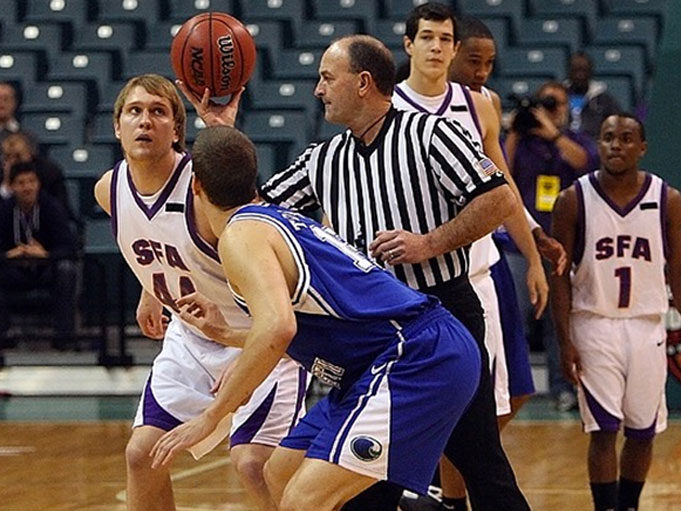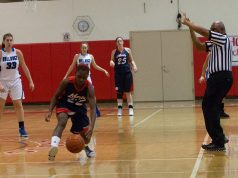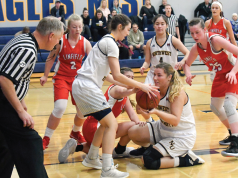Jump balls set the tone for the rest of the game. It’s the first action directly related to the game, and that first impression can be a lasting one. With a good toss, you’ve started the game properly.
Some may think that the opening toss isn’t that big a deal because it only occurs once, but consider the ramifications of a poor toss:
- The referee already appears incompetent to players and coaches.
- If the toss is too far to one side, you’ve planted the seed to the offended team that the officiating isn’t fair.
A bad toss makes officials look bad, a perception which is often difficult to overcome.
The procedure
For purposes of this article, the references are for two-person crews; however, many of the same procedures and philosophies apply to three-person crews.
After the introductions and anthem, the referee takes the ball and moves to a spot near the far sideline, facing the scorer’s table. Allow ample time for the players to get settled into their spots. While that occurs, the umpire checks with the table personnel to ensure they are ready. It’s also a good idea for the umpire to glance at the game and shot clocks to see that they are set properly to start the game. The umpire then takes a position at the intersection of the sideline and the division line directly in front of the table.
Before entering the jump circle, the referee makes eye contact with the umpire, who signals to the referee that table personnel and the umpire are ready to go. Both officials make sure the teams are facing the correct direction.
While still outside the circle, the referee asks each team’s captain if their respective teams are ready to go. Tell the players to hold their spots to avoid violations. Blow the whistle with a sharp blast before entering the circle.
Before tossing the ball, you may want to use a bit of preventive officiating with the jumpers. Tell them to jump straight up and not into each other; and tell them not to tap the ball on the way up. Just before the toss, the umpire uses the “do not start clock” signal (open hand raised above head). The referee tosses the ball high enough that the players tap the ball on its downward flight.
The umpire must maintain a wide field of vision while the referee administers the toss. The umpire watches both jumpers and all other players around the circle to spot fouls and violations.
The umpire has the initial responsibility of judging the toss. If it’s a good one, start the clock as soon as the ball is touched legally by a jumper. If the toss is a bad one, the umpire blows the whistle and calls for a re-jump, using the jump ball signal. Why does the umpire call back a bad toss? For safety reasons, the referee should not have the whistle in the mouth during the toss. By the time the referee judges a bad toss, finds the whistle and blows it, players are likely moving downcourt with the ball. That’s an awkward delay.
Some referees tell umpires that the referee is the only one who should call for a re-toss. Because of the delay and the poor vantage point for judging the direction of the toss, that’s not realistic. Trust the umpire to use good judgment.
What constitutes a bad toss? For starters, very few tosses should be called back. Again, you don’t want to start out the game out of sync. However, if a toss clearly favors one side or the toss is so far back over the referee’s head that neither jumper can touch it, blow it back. Don’t nitpick; only call for a re-jump when the toss is obviously poor. When in doubt, let it go.
Different styles
Two of the more commonly accepted methods for tossing the ball are the one-handed toss the and the two-handed toss. The one-handed toss is covered later in this column.
No matter which style is best for you, practice it regularly so your games start correctly.
Balls out of bounds
One trouble spot during jump ball coverage is a ball that is knocked out of bounds behind the referee on the sideline opposite the umpire. Most of the time, the referee doesn’t have enough time to get out of the jump circle and see what’s going on behind the referee. Four principles apply:
- If the referee knows the ball is out of bounds and knows who touched it last, make the call.
- If the umpire knows the ball is out of bounds and knows who touched it last, make the call.
- If the referee knows the ball is out of bounds but is unsure who touched it last, stop the clock. Then, check with the umpire. If the umpire knows who touched it last, the umpire signals the direction.
- If neither official is sure who touched it last, immediately signal for a re-jump.
Don’t guess a direction; you’re better off re-jumping than guessing wrong.
After the jump
As the jump ball occurs, the referee must think safety. Cover up if necessary by placing your tossing arm in front of your face and your off hand in front of your groin. After the toss, the referee should stay near the jump circle until the players clear the area. If you try to move to the sideline too quickly, you’l likely run into players and risk injury.
The umpire must read the direction of the toss. If the ball is tapped toward the frontcourt and a fast break ensues, the umpire must sprint toward the endline and become the lead. The referee reads the umpire’s movement, lets the players clear the jump circle area, then backs out toward the sideline and becomes the trail.
If the ball is tapped safely into the backcourt and is not near the backcourt endline, the umpire watches action around the catch from near the starting position. Then, if there’s no immediate defensive pressure (usually there isn’t because the defensive team is moving downcourt), the umpire moves to the frontcourt endline and becomes the lead. If the catch of the tapped ball is challenged or there is immediate defensive pressure, the umpire must watch that action until the referee can. Once the referee has picked up on-ball coverage, the umpire moves to the frontcourt endline and becomes the lead. The referee becomes the trail.
If the ball is tapped backward toward the backcourt endline, the umpire must move with the ball toward the backcourt endline to judge potential out-of-bounds violations. The referee must read the umpire’s movements, swing out toward the sideline and move to the frontcourt endline and become the lead. The umpire, already positioned in the backcourt, is the trail.
The direction of the tap dictates officiating movements. No matter where you end up, be sure the floor is balanced so two officials don’t end up on the same side of the court.
After the ball is possessed, the trail should glance at the alternating-possession arrow to make sure it is pointing in the right direction. If it isn’t, wait for the first dead-ball and correct it. There’s no need to stop play immediately in that situation.
General tips
Remember these points during jump ball administration:
- Before administering the jump ball, check with both team captains to ensure both teams are ready.
- Check with the umpire to make sure the umpire and table personnel are ready.
- Blow the whistle outside the jump ball circle before entering. Immediately take the whistle out of your mought for safety.
- For a one-handed toss, make sure your elbow is directly below the ball and perpendicular to the floor to ensure a straight toss.
- Place your foot between the jumpers’ pivot feet to create space.
- Keep the ball at your side.
- Bend your knees slightly; using your leg strength will help toss the ball high.
- For a one-handed toss, keep your palm open to the sky to ensure a wrist spin doesn’t create a bad toss.
- The toss should be straight and slightly higher than the players can jump so the players tap the ball on the way down.
If you practice the jump ball toss often, read your partner’s movements to ensure proper court coverage and communicate effectively with table personnel and your partner, your games will get off to a good start.
What's Your Call? Leave a Comment:
Note: This article is archival in nature. Rules, interpretations, mechanics, philosophies and other information may or may not be correct for the current year.
This article is the copyright of ©Referee Enterprises, Inc., and may not be republished in whole or in part online, in print or in any capacity without expressed written permission from Referee. The article is made available for educational use by individuals.



















